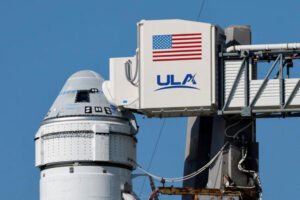Boeing’s new Starliner astronaut capsule will launch Saturday with a long-delayed first triplet test flight, a milestone in the beleaguered space giant’s goal to compete with Elon Musk’s SpaceX in the astronaut launch business.
The CST-100 Starliner, carrying two astronauts, takes off at 12:25 p.m. ET (1625 GMT) from NASA’s Kennedy Space Center in Florida, attached to a Boeing-Lockheed Martin joint venture United Launch Alliance (ULA) Atlas V rocket.
The May 6 countdown was interrupted just two hours before launch due to a faulty pressure valve on the Atlas rocket. A helium leak and another problem were later discovered in the Starliner’s propulsion system. According to Boeing and NASA, everything is resolved.
“It’s a test flight, we know we’re going to learn some things,” Mark Nappi, vice president of Boeing’s commercial team, said at a press conference on Friday. A bubble-shaped capsule and crew are on their way to the International Space Station (ISS), two years after Starliner made its first test trip to an orbiting laboratory without astronauts.

Boeing, whose commercial planes have been plagued by crises with the 737 MAX jet, needs a win for its Starliner space project, which is several years behind schedule and more than $1.5 billion over budget. The company is a longtime NASA contractor that built modules for the decades-old ISS and rockets designed to carry astronauts to the moon.
But it has never before built its working spacecraft, hampered by years of software problems, technical glitches, and mismanagement of the Starliner program. Boeing has struggled, but SpaceX has become a reliable taxi to orbit for the US space agency, which supports a new generation of privately built spacecraft to fly astronauts into low Earth orbit and, under the ambitious Artemis program, to the moon and finally Mars.
The Starliner would compete head-to-head with SpaceX’s Crew Dragon capsule, which as of 2020 has been NASA’s only vehicle to launch ISS crew members into orbit from US soil. NASA has long sought two U.S. missions to the station in addition to joint astronaut flights on the Russian Soyuz rocket.
The inaugural crew of the seven-seat Starliner includes two veteran NASA astronauts: Barry “Butch” Wilmore, 61, a retired U.S. Navy captain and fighter pilot, and Sunita “Suni” Williams, 58, former Navy helicopter test pilot with experience flying more than 30 different aircraft. They spent a total of 500 days in space during two ISS missions. Wilmore is the commander of Saturday’s flight and Williams is in the pilot’s seat.
Although the Starliner is designed to fly independently, the crew can take control of the spacecraft if necessary. During the test flight, Wilmore and Williams will practice manually piloting the vehicle en route to the space station, where it will remain docked for at least eight days before returning to Earth.
If Boeing postpones its Saturday launch attempt, the company has backup launch options for Sunday, Wednesday, and Thursday. If it doesn’t arrive by Thursday, some parts of the Starliner and the rocket will have to be replaced or upgraded, causing weeks or possibly months of delays as the schedule conflicts with other ULA missions and the ISS.
Saturday’s flight is the first manned Atlas trip into space since earlier versions of the rocket dynasty launched American astronauts, including John Glenn, into orbit during NASA’s Mercury program in the 1960s. If all goes according to plan, the capsule will reach the space station after a flight of about 26 hours and dock with an orbiting research station about 250 miles (400 km) above Earth.
Wilmore and Williams will remain on the space station for about a week before traveling in a capsule back to Earth for a parachute and airbag landing in the desert southwest of the United States, the first time a NASA crew has ever completed a mission.











